Glycolysis is the major pathway for the utilization of glucose in the body. Glycolysis is defined as the sequence of reactions for the breakdown of Glucose (6-carbon molecule) to two molecules of pyruvic acid (3-carbon molecule) under aerobic conditions; or lactate under anaerobic conditions along with the production of ATP. This was described by Embden, Meyerhof and Parnas. Hence, it is also called as Embden Meyerhof pathway.
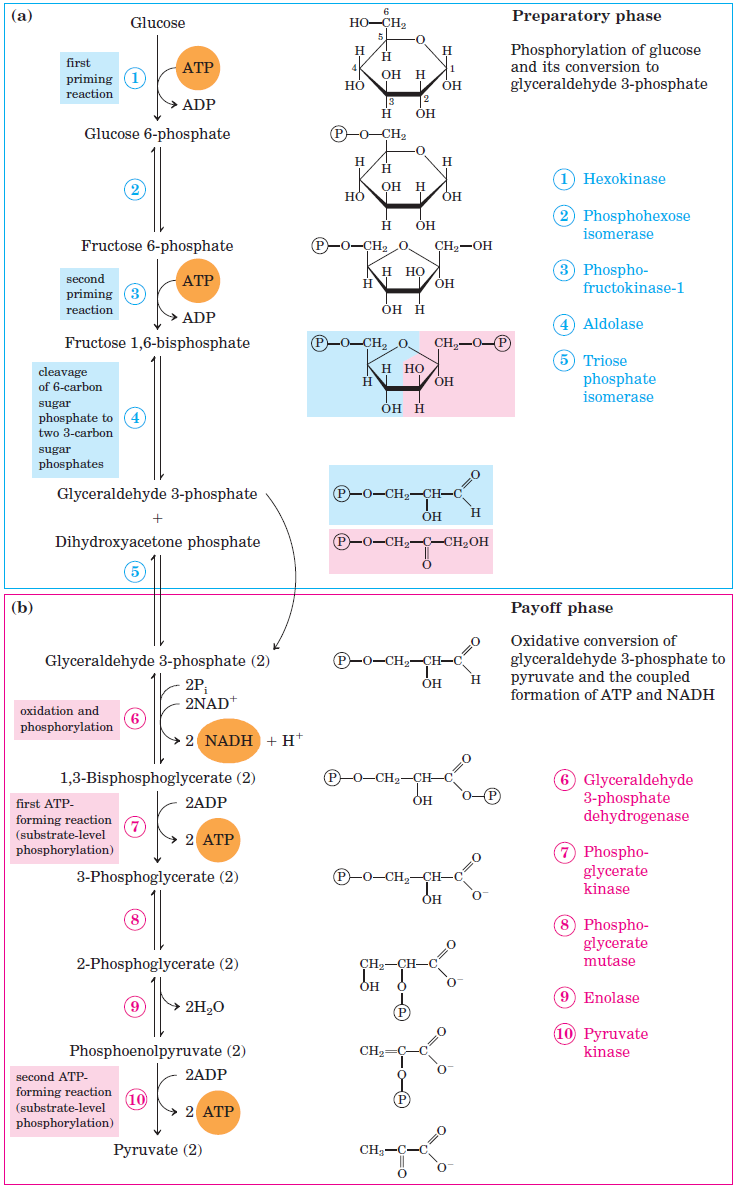

Site of Glycolysis
Glycolysis takes place in cytosol of all the cells of the body. It is the major pathway for ATP synthesis in tissues lacking mitochondria, e.g. erythrocytes, cornea, lens etc.
Types of Glycolysis
Glycolysis is the only pathway which can operate aerobically and anaerobically.
Aerobic Glycolysis: It occurs when oxygen is readily available. Final product is pyruvate along with the production of ATPs.
Anaerobic Glycolysis: It occurs when oxygen is scarce. Final product is lactate along with the production of ATPs.
Steps of Glycolysis
The breakdown of glucose molecule is brought about by sequential reaction of 10 enzymes which can be divided into two phases:
- Phase 1: Preparatory Phase
This phase is also called glucose activation phase. In the first stage of glycolysis, glucose is phosphorylated, isomerized, phosphorylated again and cleaved to yield two triose molecules. This comprises the first five reactions, 1, 2, 3, 4 and 5 which convert Glucose to two molecules of Glyceraldehyde-3-Phosphate. These reactions consume 2ATPs per glucose.
- Phase 2: Payoff Phase
This phase is also called energy extraction phase. In stage, a series of changes convert glyceraldehyde 3-phosphate to pyruvate. This stage produces 4 ATPs per glucose molecule for a net yield of 2 ATPs per glucose.
Step 1: Uptake and Phosphorylation of Glucose
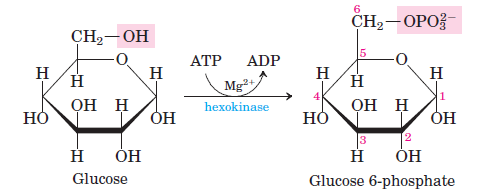
- Glucose is phosphorylated to glucose-6-phosphate.
- This reaction is catalysed by the specific enzyme glucokinase in liver cells and by non specific enzyme hexokinase in liver and extrahepatic tissue. The enzyme splits the ATP into ADP, and the phosphate group is added onto the glucose.
- This is irreversible regulatory reaction step of glycolysis.
- This is the flux generating step of glycolysis.
- Mg2+ acts as cofactor.
Step 2: Isomerization of Glucose-6-Phosphate
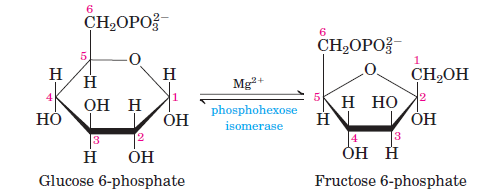
- Glucose-6-phosphate is isomerised to Fructose-6-phosphate by the enzyme Phosphohexose Isomerase.
- It involves Aldose-Ketose Isomerism.
- It is freely reversible reaction.
Step 3: Phosphorylation of Fructose-6-Phosphate

- Fructose-6-phosphate is further phosphorylated to Fructose 1,6-bisphosphate.
- One ATP is utilized. The enzyme phosphofructokinase-1 catalyses the transfer of a phosphate group from ATP to fructose-6-phosphate.
- This step is second irreversible step in glycolysis.
- Rate limiting commited step of glycolysis.
- Also called bottle neck of glycolysis.
Step 4: Cleavage of Fructose 1,6-Bisphosphate

- Enzyme aldolase splits 6-carbon Fructose 1,6-bisphosphate into two 3-carbon compounds, namely, Glyceraldehyde-3-phosphate and Dihydroxy acetone phosphate (DHAP).
- Aldolase is a Lyase.
- This reaction is reversible.
Step 5: Isomerization of Dihydroxyacetone Phosphate
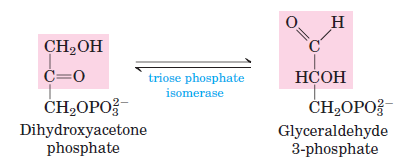
- As GAP is on the direct pathway of glycolysis, whereas DHAP is not. DHAP is isomerized to Glyceraldehyde 3-phosphate by the enzyme phosphotriose isomerase.
- Hence two molecules of glyceraldehyde 3-phosphate are formed from one molecule of glucose.
This inter conversion is reversible.
Step 6: Dehydrogenation of Glyceraldehyde-3-Phosphate

- Glyceraldehyde-3-phosphate is oxidised to a high energy compound 1,3-bisphosphoglycerate by enzyme glyceraldehyde-3-phosphate dehydrogenase.
- It is a NAD dependent reversible reaction which generates NADH. This NADH enters in mitochondria by Malate-Aspartate shuttle or Glycerophosphate shuttle under aerobic conditions. But in anaerobic conditions, NADH is utilized by Lactate Dehydrogenase, NAD+ is regenerated.
Step 7: Conversion of 1,3-Bisphosphoglycerate to 3-Phosphoglycerate

- The enzyme phosphoglycerate kinase transfers the high-energy phosphoryl group from the carboxyl group of 1,3-bisphosphoglycerate to ADP, forming ATP and 3-phosphoglycerate.
- This is only kinase reaction in glycolysis, which is reversible.
- This step generates ATP at substarate level phosphorylation.
Step 8: Inter-Molecular Shift of Phosphate Group

- Phosphoglycerate mutase shifts the phosphate group from 3rd to 2nd carbon atom, converting 3-phospho glycerate to 2-phospho glycerate.
- This is reversible reaction.
- Mg2+ is essential for this reaction.
Step 9: Dehydration of 2-Phosphoglycerate
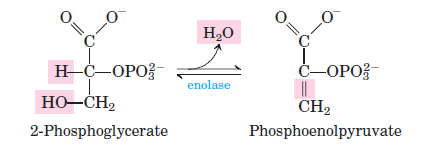
- Enolase converts 2-phosphoglycerate to phosphenol pyruvate.
- Enolase is dependent on Mn2+ and Mg2+.
- This is reversible reaction.
- Fluoride inhibits enolase. This property can be used when it is required to prevent glycolysis in blood prior to the estimation of blood glucose.
Step 10: Conversion of Phosphoenolpyruvate to Pyruvate
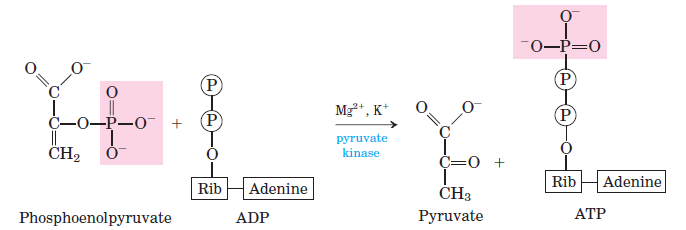
- Pyruvate kinase catalyzes the conversion of phosphenol pyruvate to pyruvate.
- This is the second step in glycolysis that generates ATP at substrate level phosphorylation.
- This is irreversible reaction.
Additional Step in Anaerobic Condition
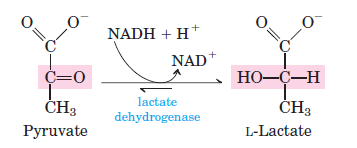
- When animal tissues cannot be supplied with sufficient oxygen to support aerobic oxidation of the pyruvate and NADH produced in glycolysis, NAD+ is regenerated from NADH by the reduction of pyruvate to lactate by Lactate Dehydrogenase (LDH).
- Tissues that function under hypoxic conditions eg. skeletal muscle, smooth muscle, erythrocytes produce lactate. In erythrocytes, even under aerobic conditions, glycolysis terminates in lactate because of absence of mitochondria.
Net energy yield in Glycolysis
Energy Yield in Aerobic Glycolysis
| Step No. | Enzyme | Source | No. of ATP |
|---|---|---|---|
| 1 | Hexokinase | – | -1 |
| 3 | Phosphofructokinase | – | -1 |
| 6 | Glyceraldehyde-3-phosphate dehydrogenase | NADH | (+2.5)x2=5 |
| 7 | Phosphoglycerate Kinase | ATP | (+1)x2=2 |
| 10 | Pyruvate Kinase | ATP | (+1)x2=2 |
| Net Energy Yield | 9-2= 7 ATPs |
Energy Yield in Anaerobic Glycolysis
| Step No. | Enzyme | Source | No. of ATP |
|---|---|---|---|
| 1 | Hexokinase | – | -1 |
| 3 | Phosphofructokinase | – | -1 |
| 7 | Phosphoglycerate Kinase | ATP | (+1)x2=2 |
| 10 | Pyruvate Kinase | ATP | (+1)x2=2 |
| Net Energy Yield | 4-2= 2 ATPs |

Tnx
You,re welcome.
Great Job! Well Done!